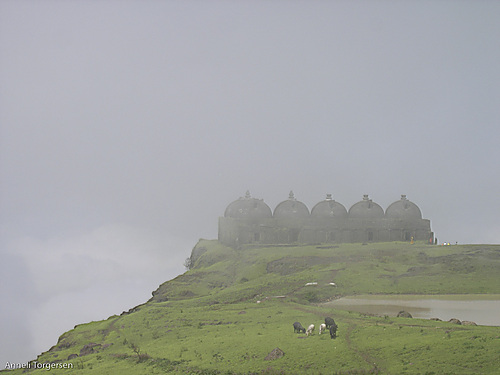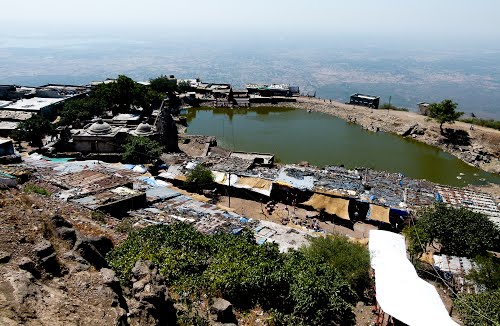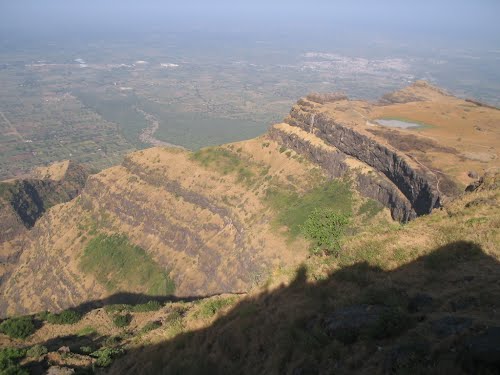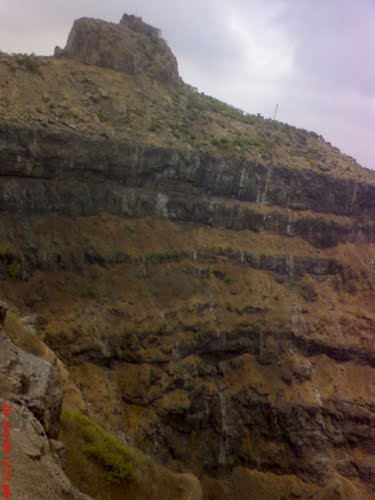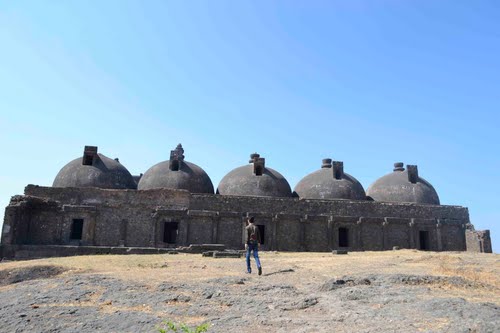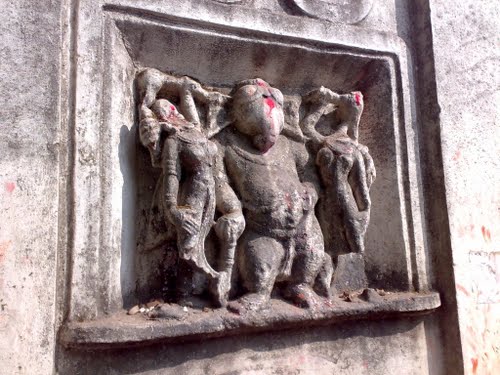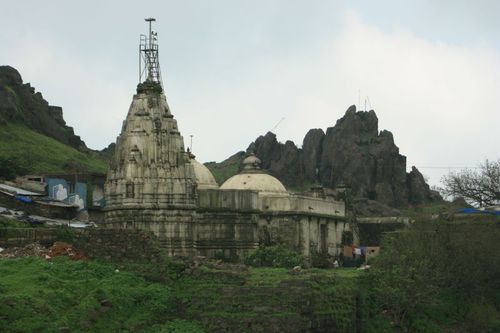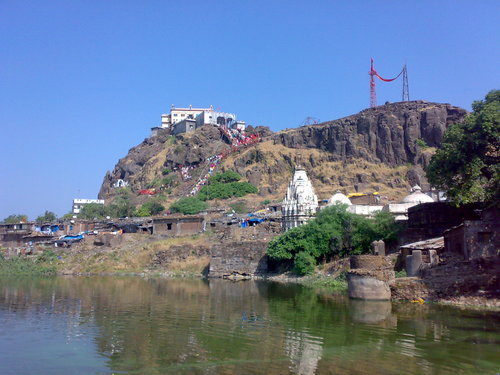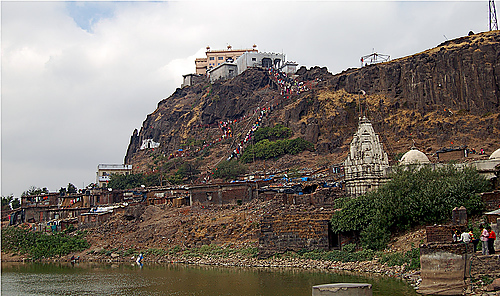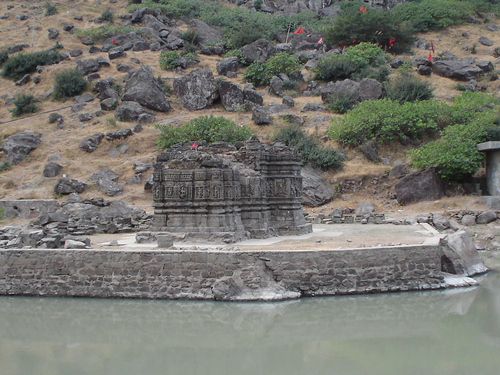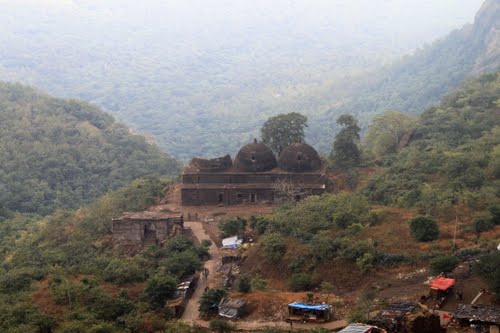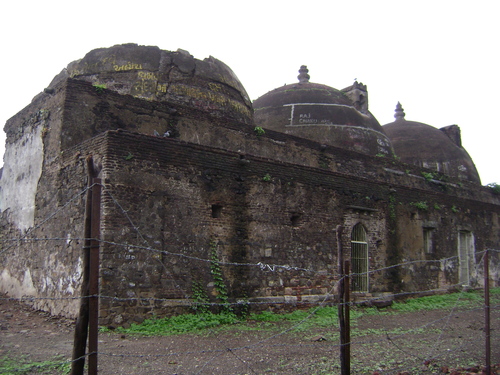Champaner-Pavagadh Archaeological Park, a UNESCO World Heritage Site, is located in Panchmahal district in Gujarat, India. It is located around the historical city of Champaner, a city which was built by Sultan Mahmud Begada of Gujarat. The heritage site is studded with forts with bastions starting from the hills of Pavagadh, and extending into the city of Champaner. The park's landscape includes archaeological, historic and living cultural heritage monuments such as chalcolithic sites, a hill fortress of an early Hindu capital, and remains of the 16th-century capital of the state of Gujarat. There are palaces, entrance gates and arches, mosques, tombs and temples, residential complexes, agricultural structures and water installations such as stepwells and tanks, dating from the 8th to the 14th centuries. The Kalika Mata Temple, located on top of the 800 metres high Pavagadh Hill, is an important Hindu shrine in the region, attracting large numbers of pilgrims throughout the year.
The transition between Hindu and Muslim culture and architecture in the late 15th to early 16th century is documented in the park, particularly the early Islamic and pre-Mughal city that has remained without any change. It was inscribed by UNESCO as a World Heritage Site in 2004.
History
Early history
Judging by early archaeological remains and according to records, the area had already been inhabited in the chalcolithic period; however, it remained neglected until approximately 400 AD. The history also reports a local legend that the divinity of the hills was derived from the right toe of the goddess Kalika, which had apparently fallen on the hill.
The name Champaner is derived from Champa, who was either a Vania or a Kanbi. He established this city during the rule of Vanraj Chavda of Anhilwad Patan (from 746 to 806 AD). In the eleventh century, Ram Gaur Tuar ruled, and Champaner was under the Anhilwad until 1297 or so when they were defeated by Alauddin Khilji, who made it their stronghold. During this period, the Chauhan Rajputs had also settled in Champaner. The Pavagadh Hill was where the Solanki kings and Khichi Chauhans built fortresses and ruled from. However, they lost their authority in Champaner in 1484. The Rajputs ruled on the northeastern side of the foothills of Pavgarh Hill below the fortress of Pavgadh. In 1418 and in about 1450, they managed to fight off their neighbour, Rao of Idar, and the Muslim rulers of Ahmedabad, thanks to the protection provided by the hill. However, in 1483, when Mahmud Begada’s captain, Malik Asad, was raiding through Champaner, he was attacked and killed by Raval Jaisingh. What ensued in the following years was the complete defeat of the Rajputs by Sultan Begada. The hill was surrounded and the fort held under siege for more than a year and was finally captured on 17 November 1484, when Kivamul Mulk and Malik Ayaz Sultani penetrated the walls and broke the main gate, destroyed the army and injured the leaders of the Rajputs. Raval Jaisingh was wounded and for six months was given amnesty but was then killed since he refused to convert to Islam.
Raval’s son, however, converted to Islam and was made a noble with the title "Nizam-ul-Mulk". After the fort was seized, Mahmud renamed the city "Muhmudabad Champaner". It was during this period that Mahmud laid the foundation stone for his mosque. He built elaborate ornate structures, fortified both the forts, made the hill fort his Mauliya (meaning Lord of the Hill) and his citadel over a period of 23 years and eventually moved his capital from Ahmadabad to Champaner.
During this period, Champaner was famous for mangoes, sandalwood trees (used then for house building and sword blades), and colourful silks. Merchants and craftsmen prospered. Mahmud died in 1511 and his successors continued to rule from Champaner until the death of Bahadur Shah (1536). The city of Champaner had been very well planned with streets and whitewashed stone houses. In 1526, young Sikander Shah died and Bahadur Shah became the next ruler of Champaner. In 1535, the Mughal Emperor Humayun invaded Champaner and looted the coffers. Upon Bahadur's death in 1536, the capital and the court shifted back to Ahmadabad. The city fell into rapid decline, was largely abandoned and for several centuries was neglected and almost deserted.
Later history
The British visited the town of Champaner in 1803, at which time there were only 500 people residing there. The old city was in ruins and wildly overgrown. They refounded it and it became a great exporter of silk, with facilities for washing and preparing raw silk. However, a cholera epidemic reduced the population to 400 families by 1812. When the British finally usurped the area on 13 July 1829, it was almost deserted; efforts at that time to populate the place by inducting cultivators with an incentive of Rs 1260 to develop the lands at that time also failed. In 1879, a few Bhil and Naikda tribes resided there, but over the next few years, it became well known in India for its rulers and the monuments left behind by them.

